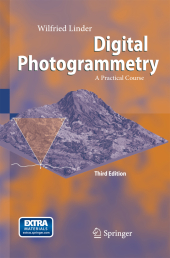 Neuerscheinungen 2014Stand: 2020-02-01 |
Schnellsuche
ISBN/Stichwort/Autor
|
Herderstraße 10
10625 Berlin
Tel.: 030 315 714 16
Fax 030 315 714 14
info@buchspektrum.de |

Wilfried Linder
Digital Photogrammetry
A Practical Course
3. Aufl. 2014. xv, 220 S. 235 mm
Verlag/Jahr: SPRINGER, BERLIN; SPRINGER BERLIN HEIDELBERG 2014
ISBN: 3-642-44517-9 (3642445179)
Neue ISBN: 978-3-642-44517-0 (9783642445170)
Preis und Lieferzeit: Bitte klicken
With several tutorials of increasing complexity, accompanied by texts explaining further theory, this third edition is an "all-in-one" combination of basic theory and practical exercises on digital photogrammetry.
1.1 Basic idea and main task of photogrammetry If you want to measure the size of an object, let´s say the length, width and height of a house, then normally you will carry this out directly at the object. Now imagine that the house didn´t exist anymore - it was destroyed, but some historic photos exist. Then, if you can determine the scale of the photos, it must be pos- ble to get the desired data. Of course you can use photos to get information about objects. This kind of - formation is different: So, for example, you may receive qualitative data (the house seems to be old, the walls are coloured light yellow) from photo interpre- tion, or quantitative data like mentioned before (the house has a base size of 8 by 6 meters) from photo measurement, or information in addition to your background knowledge (the house has elements of the "art nouveau" style, so may be c- th structed at the beginning of the 20 century), and so on.
Included software and data.- Scanning of photos.- Example 1: A single model.- Example 2: Aerial triangulation.- Example 3: Some special cases.- Programme description.
Wilfried Linder, born in 1959, studied mathematics and geography at the University of Hannover (1979-85). Thereafter, he was employed as a scientific assistant at the Universities of Osnabrück/Vechta, Hannover and Düsseldorf. In 1990 he received his Ph.D in geography, followed in 1993 by one in geodesy. He is now a member of the Institute of Geography at the University of Düsseldorf, where he is responsible for the fields of photogrammetry, remote sensing, digital cartography and geo information systems (GIS).


